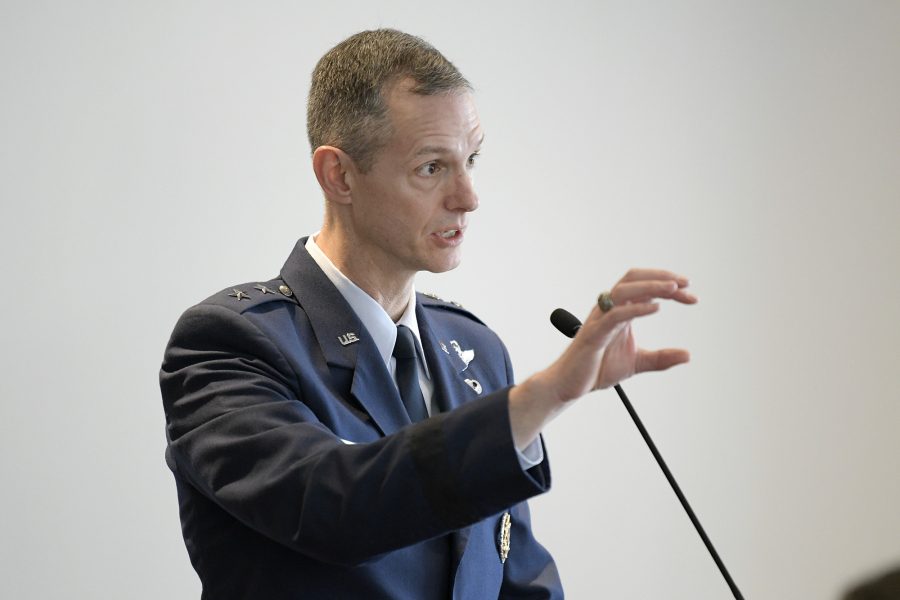The US-led coalition’s air operations may have slowed in the fight against the Islamic State group, but the US Air Force’s mission to train the Iraqi Air Force has started to “pay dividends” as the Iraqis take on more strikes on their own, a top coalition commander said.
Much of this training and progress is on hold, however, as the US has turned its attention to protecting troops from Iranian threats, rather than training and anti-ISIS operations, following the Jan. 3 strike on a top Iranian military leader and the resulting ballistic missile attack on al Asad AB, said USAF Maj. Gen. Alex Grynkewich, deputy commander of Combined Joint Task Force-Operation Inherent Resolve.
ISIS is a “thinking and learning adversary” and the coalition would be “at peril” to underestimate the group since much of the same conditions that allowed it to grow still persist, Grynkewich said Jan. 22 at an AFA Mitchell Institute for Aerospace Studies event in Arlington, Va.
ISIS has not really taken advantage of the pause, at least not enough to really worry the coalition. However, “over the long term if less pressure is put on ISIS” that could change, Grynkewich said. “We certainly want to get back to providing that overall pressure to keep them down and ensure that enduring defeat.”
A key effort in this is the 321st Air Expeditionary Wing’s mission inside Iraq and Syria. While half of the wing’s mission is keeping airfields operating, the other half is working directly with the Iraqi Air Force to grow its own capabilities.
The Iraqi Air Force has improved its ability to collect intelligence and develop targets. Recently, Iraqi aircraft, such as its F-16s, have been conducting “a couple [of] strikes per month,” though they are “certainly picking up the pace over time” as they have shown to be “eager and willing,” Grynkewich said.
As this pace grows, US and coalition airstrikes have slowed to about two to three per week, though they are still hitting important targets such as weapons caches across Syria and Iraq, he said.
While the operations have been ongoing in Syria, the pause in Iraq has changed how the coalition can operate. “Broadly speaking, most training activities have stopped,” Grynkewich said. At local, individual levels some discussions are ongoing, but the “higher-level advising efforts” are suspended.
The coalition is “responding to the demand signal from the Iraqi government,” which is being worked out at a higher level, he said.
This suspension dates back to the immediate reaction from the Jan. 3 drone strike that killed Iranian Quds Force boss Qassem Soleimani at the Baghdad airport, and the Jan. 7 Iranian ballistic missile attack at Al Asad and Erbil bases in Iraqi.
While there were no fatalities from the attack, a number of US forces—“in the teens”—had to be taken out of Iraq to Landstuhl Regional Medical Center in Germany and to Kuwait for evaluation and further treatment related to traumatic brain injuries. Grynkewich would not go into specifics of the extent of these injuries, saying only that, “We got folks to Landstuhl who needed to get to Landstuhl. We will do whatever we need to take care of the soldiers and airmen who are injured.”
No one was killed in the attack because of the advanced warning US forces received and the way forces reacted.
“The low-level commanders, airmen and soldiers on the ground, made some tremendous decisions in a time of great ambiguity” to move forces around and into bunkers in “rapid order,” he said.
Since the attack, there have been “harassing fires” from Iranian-backed militias, but no large-scale attacks. The presence of these militias has been “part of the operational environment we have to deal with,” he said. These groups constrain the coalition’s freedom to maneuver and “threaten us.”
In recent months, there have been “a couple casualties from ISIS, but most of the attacks come from Shia militia groups who are launching rockets at our bases and trying to kill someone to make a point,” he said.
